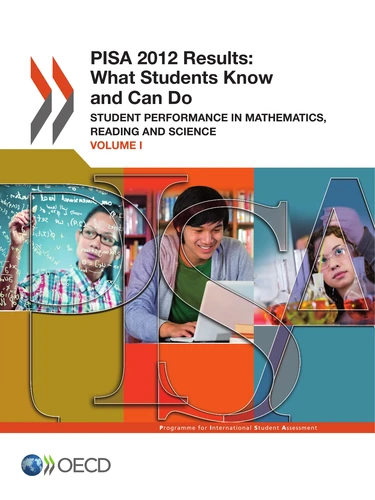Pisa 2012 Results. Volume 1, What Students Know and Can Do
Par :Formats :
Disponible dans votre compte client Decitre ou Furet du Nord dès validation de votre commande. Le format PDF est :
- Compatible avec une lecture sur My Vivlio (smartphone, tablette, ordinateur)
- Compatible avec une lecture sur liseuses Vivlio
- Pour les liseuses autres que Vivlio, vous devez utiliser le logiciel Adobe Digital Edition. Non compatible avec la lecture sur les liseuses Kindle, Remarkable et Sony
 , qui est-ce ?
, qui est-ce ?Notre partenaire de plateforme de lecture numérique où vous retrouverez l'ensemble de vos ebooks gratuitement
Pour en savoir plus sur nos ebooks, consultez notre aide en ligne ici
- Nombre de pages564
- FormatPDF
- ISBN978-92-64-20878-0
- EAN9789264208780
- Date de parution11/02/2014
- Copier Coller01 page(s) autorisée(s)
- Protection num.Digital Watermarking
- Taille9 Mo
- Transferts max.Autorisé
- Infos supplémentairesPDF avec Watermark
- ÉditeurOECD
Résumé
This first volume of PISA 2012 results summarises the performance of students in PISA 2012. It describes how performance is defined, measured and reported, and then provides results from the assessment, showing what students are able to do in mathematics. After a summary of mathematics performance, it examines the ways in which this performance varies on subscales representing different aspects of mathematics literacy.
Given that any comparison of the outcomes of education systems needs to take into consideration countries’ social and economic circumstances, and the resources they devote to education, the volume also presents the results within countries’ economic and social contexts. In addition, the volume examines the relationship between the frequency and intensity of students’ exposure to subject content in school, what is known as “opportunity to learn”, and student performance.
The volume concludes with a description of student results in reading and science. Trends in student performance in mathematics between 2003 and 2012, in reading between 2000 and 2012, and in science between 2006 and 2012 are examined when comparable data are available. Throughout the volume, case studies examine in greater detail the policy reforms adopted by countries that have improved in PISA.
Given that any comparison of the outcomes of education systems needs to take into consideration countries’ social and economic circumstances, and the resources they devote to education, the volume also presents the results within countries’ economic and social contexts. In addition, the volume examines the relationship between the frequency and intensity of students’ exposure to subject content in school, what is known as “opportunity to learn”, and student performance.
The volume concludes with a description of student results in reading and science. Trends in student performance in mathematics between 2003 and 2012, in reading between 2000 and 2012, and in science between 2006 and 2012 are examined when comparable data are available. Throughout the volume, case studies examine in greater detail the policy reforms adopted by countries that have improved in PISA.
This first volume of PISA 2012 results summarises the performance of students in PISA 2012. It describes how performance is defined, measured and reported, and then provides results from the assessment, showing what students are able to do in mathematics. After a summary of mathematics performance, it examines the ways in which this performance varies on subscales representing different aspects of mathematics literacy.
Given that any comparison of the outcomes of education systems needs to take into consideration countries’ social and economic circumstances, and the resources they devote to education, the volume also presents the results within countries’ economic and social contexts. In addition, the volume examines the relationship between the frequency and intensity of students’ exposure to subject content in school, what is known as “opportunity to learn”, and student performance.
The volume concludes with a description of student results in reading and science. Trends in student performance in mathematics between 2003 and 2012, in reading between 2000 and 2012, and in science between 2006 and 2012 are examined when comparable data are available. Throughout the volume, case studies examine in greater detail the policy reforms adopted by countries that have improved in PISA.
Given that any comparison of the outcomes of education systems needs to take into consideration countries’ social and economic circumstances, and the resources they devote to education, the volume also presents the results within countries’ economic and social contexts. In addition, the volume examines the relationship between the frequency and intensity of students’ exposure to subject content in school, what is known as “opportunity to learn”, and student performance.
The volume concludes with a description of student results in reading and science. Trends in student performance in mathematics between 2003 and 2012, in reading between 2000 and 2012, and in science between 2006 and 2012 are examined when comparable data are available. Throughout the volume, case studies examine in greater detail the policy reforms adopted by countries that have improved in PISA.























